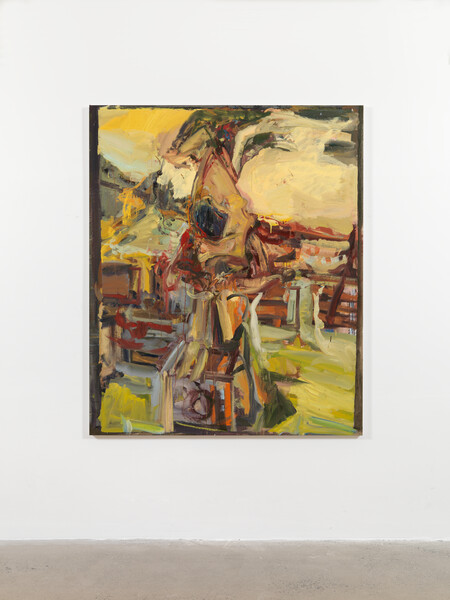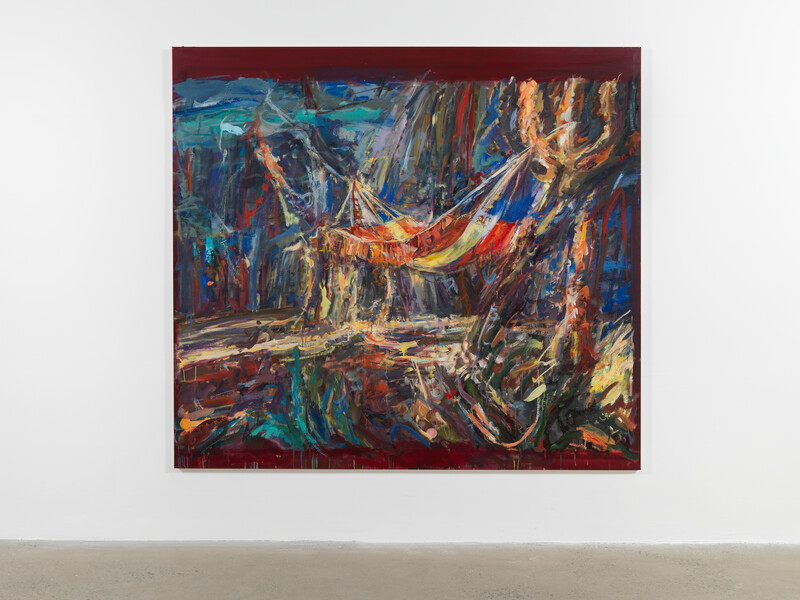Catherine Goodman

Catherine Goodman, Tiger Girl, 2018, Oil on linen © Catherine Goodman
Catherine Goodman
This resource has been produced to accompany the exhibition 'Catherine Goodman. Eve’ at Hauser & Wirth Somerset from 19 January until 6 May 2019.
All group visits to Hauser & Wirth Somerset must be booked at least two weeks prior to arrival. Register your interest in a school booking here or contact the Education Team at education@hauserwirth.com. If you have questions or additional requests, please call our team on +44 (0) 1749 814 060.
About Catherine Goodman
Catherine Goodman (b. London 1961) is an artist based in London and Somerset. Goodman trained at London’s Camberwell School of Arts & Crafts, and the Royal Academy Schools, at which she won the Royal Academy Gold Medal in 1987. Since leaving the Royal Academy, Goodman has worked at her studios in London and India and has had numerous solo exhibitions, including Portraits from Life at the National Portrait Gallery in 2014. She won First Prize in the BP Portrait Award in 2002.
Her visual language runs across genres, acknowledging the influence of literature, film, music, drawing from art and life, enriching her work. Goodman has developed her own subtle mythology, the motifs of which carry through her drawings and paintings, whether of real or imagined landscapes and characters, or impressions conjured from memory.
She has a longstanding interest in artists’ development and education, as well as the importance of drawing to artistic practice. In 2000, Goodman co-founded the Royal Drawing School with HRH The Prince of Wales in Shoreditch, London to address the increasing absence of observational drawing programmes in art education.
What does her work look like?
Although Goodman is known for her portraits, her practice includes expressionistic landscapes and cityscapes, interior scenes of her house and studio, vigorous sketches and experimental collages. Central to her process is the act of drawing from observation, whether from life, objects or the great masters and their works.
What are her main themes?
In this series of works Goodman is interested in the relationship between the figure and the landscape. The paintings explore how a figure can merge or disrupt an existing space. The addition of a child in a tiger costume for example, transforms the luscious landscape into a fantasy environment; see ‘Tiger Girl’, 2018.

Catherine Goodman, Beekeeper, 2018, Oil on linen © Catherine Goodman

Catherine Goodman, Hanuman's Heart, 2018, Oil on linen © Catherine Goodman
What inspires her work?
In her Foundation year at the Camberwell School of Arts & Crafts Goodman visited India for the first time, and has been back almost every year since; she also frequently visits Italy. Her vigorous painting and heightened colouring style draws on the experience of the immense mountains and vast landscapes of these countries, even though her paintings are never intended to depict specific locations. Likewise the starting point for her figures are often people whom she knows, but they may not be so once the painting is completed.
Goodman is an avid reader and watches many films. She calls her drawings from film ‘quotations’, describing the process as a way of ‘feeding off another eye’. She often watches films by Russian director Andrei Tarkovsky, who is known for his dramatic and unconventional cinematography.
How does she title her work?
The films of Tarkovsky and her reading often inspire her titles, for example the poems of Rainer Maria Rilke or Ted Hughes. This exhibition is titled ‘Eve’ and Catherine Goodman describes her residency in Somerset as the time where her ideas for the paintings grew. Although the paintings do not reference the Garden of Eden specifically, they do show rural settings with female figures or children who appear to merge into the landscape.
How does she make her art?
Catherine Goodman describes how the preparatory drawings, in charcoal, gouache and pencil, become ‘the armature or the scaffold of every piece of work’. For over thirty years, she has drawn every single day. She says, ‘drawings hold the smells and the bones, memories, feelings and the structure of everything I do. If I lost my drawings I wouldn’t be able to make the paintings. A photograph won’t do. However good a photograph is, it gives you one rather than layers of memory’. 1
Her paintings are expressionist in style, working in oil paint on linen; they may be described as traditional in their subject matter and technique. The use of drawing as preparatory and not using photography further endorses this.
This exhibition also includes a series of flags installed in the Farmyard area. The images on the flags are taken from Goodman’s drawings, and you may be able to recognise how they relate to her paintings.
What other artists’ work does she relate to?
Goodman’s exhibition at Colnaghi in 2014 titled ‘Drawing from Veronese’ was inspired by frequent visits to the National Gallery and demonstrated that drawing from old master paintings leads to the evolution of works in their own right, rather than functional sketches that exist only as developmental tools. Artists who she makes specific reference to are Rembrandt, Frans Hals, Poussin, and Titian. She was a friend of Lucian Freud, who was a British painter and draftsman, specialising in figurative art, and known as one of the most significant 20th-century portraitists. Her work can also be considered within the context of the School of London tradition.
1 Extract from Hannah Rothschild. Catherine Goodman, The last House in the World, Marlborough, 2016.

Catherine Goodman, Charulata, 2018, Oil on paper © Catherine Goodman
GLOSSARY
Armature
A frame used to support a modelled sculpture, usually made from wire.
Avant-garde
Term used to describe new and experimental ideas and methods in art, music and literature.
Complementary Colours
Complementary colours are pairs of colours that contrast with each other more than any other colour, and when placed side-by-side make each other look brighter
Expressionist
When used with a small ‘e’ it refers generally to art, which expresses emotion.
Old Masters
The term Old Masters generally refers to the most recognised European artists, mostly painters who were working between the Renaissance and 1800.
Primary Colours
In colour theory complementary colours appear opposite each other on colour models such as the colour wheel. The colour complement of each primary colour (primaries are red, yellow and blue) can be obtained by mixing the two other primary colours together.
School of London
A term invented by artist R.B. Kitaj to describe a group of London-based artists who persisted with figurative painting during the avant-garde approaches of the 1970s.
SUGGESTED QUESTIONS AND ACTIVITIES FOR YOUR VISIT
NB. You will need to bring pencils and a sketchbook
Possible activity – make own sketchbooks before entering gallery.
Threshing Barn
What do we call paintings that feature images of people and what do we call paintings that depict the outdoors? Can you name other landscape and portrait painters? In what ways are they similar or different to these paintings?
In pairs or threes, explore the work in the room and discuss how the artist has made the paintings: where did she start, how did she develop the forms, what type of brush did she use, what paint etc? Does she work quickly or slowly, flat or on the wall, one at a time?
Explore the paintings in this gallery and choose one that depicts a figure. How would you describe the landscape that they are in? What do you imagine about this person? Are they young or old, in costume, real or imagined? What emotion do you think this person is feeling?
Why do we have our pictures taken? How has this changed over time?
What do our clothes and pose say about who we are?
Workshop Gallery
Do you know what primary colours are, can you name them?
What happens when you mix paint: red + blue =____, red + yellow =___, blue+ yellow =___.
What do we call these types of colours?
Can you find a painting where two complementary colours are next to each other, what do you think happens?
Select one painting to look at closely. Look at the colours. How are they different from what you see in nature? Have you ever seen a pink sea? (Perhaps if it’s reflecting a sunset…) Discuss warm & cool colours.
What do the colours in this painting make you feel? Happy? Sad? Scared?
What do you think is happening in this painting? Depending on ages, draw or write your responses.
Pigsty Gallery
In pairs, stand directly in front of one another and draw your partners portrait for 1 minute each, whilst drawing you must not take your eyes off your partner (do not look at what you are drawing) and at the same time, do not take your pencil off the paper.
Drawings can be made in all sorts of media, explore the different types of marks that the artist makes. Select one drawing and use your pencils to make marks in your sketchbook to show different qualities, e.g. light/dark, soft/hard, gentle/firm, fast/slow, can you think of any others?

Catherine Goodman, Departed Presence, 2018, Oil on linen © Catherine Goodman
PRACTICAL ACTIVITY PROMPTS AND IDEAS FOR DISCUSSION FOLLOWING YOUR VISIT
Key Stage 1 and 2:
Explore ways to make expressive paintings. Working from photographs in magazines produce figurative drawings in charcoal and then go outside to make pictures of landscapes in oil pastel. Select one drawing and cut it out, place it on top of a chosen landscape and make a painting of the image.
Key Stage 3 and 4:
Colour theory and colour mixing. Follow the activity above but your painting must only use red, blue and yellow paint. You must mix the paint carefully to see how broad your painterly palette can become.
What is expression in art? Discuss your understanding in relation to painting, sculpture, film and photography.
Why do artists still paint portraits when they could just take a photograph? Discuss your answers.
SUPPLEMENTARY RESEARCH
Catherine Goodman, ‘Portraits from Life’, Marlborough Fine Art in association with the National Portrait Gallery, 17 June – 23 November 2014
Catherine Goodman, ‘the last House in the world’, Marlborough Fine Art, 2016
Catherine Goodman, see www.catherinegoodman.co.uk
Resources
1 / 10









